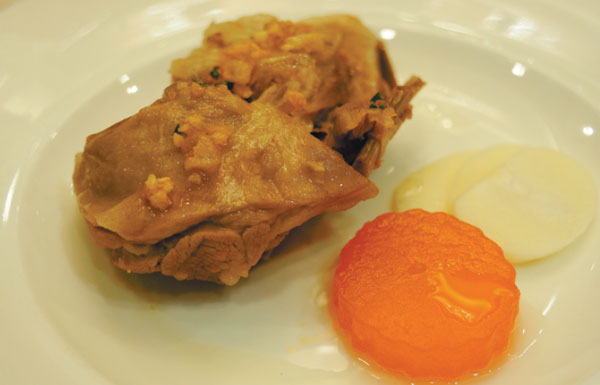Lamb to love
Winter is the time for hearty fare, and diners in the capital have made one animal a seasonal favorite, Ye Jun reports.
A good piece of lamb has always been a great temptation, especially in the cold seasons of Beijing. Quite a few good dishes of this kind command respect in the capital city - boiled goat in bronze pot at Inner Mongolia restaurant 99 Yurt, grilled sheep leg at Big Bear Roast Leg of Lamb restaurant, and grilled Australian rack of lamb prepared by Chinese chef Fu Yang at My Humble House in Parkview Green.
But if you try the lamb chop at Beijing Ningxia Hotel, you will want to add that to your list of "best lamb in Beijing".
|
Boiled mutton with pickled vegetables in casserole is a signature dish at Xixia Palace Restaurant in Beijing. Photos by Ye Jun / China Daily |
It is hard to find lamb as smooth or as flavorful as the stewed lamb chop at the hotel's Xixia Palace Restaurant.
Executive chef Ma Jianhua explains that the restaurant uses tanyang, a kind of sheep raised in arid or semi-arid grassland in the Ningxia Hui autonomous region. The sheep is famous not only for its jade-white fur, but also for its tasty meat.
Ma says tanyang feeds on many herbs on the saline, alkaline land in desert regions near the banks of the Yellow River. The geographic conditions are special: dry, windy and sunny - and there are a lot of minerals in the soil.
A helping of select stewed lamb chop weighs 200 grams and costs 168 yuan ($27.70) per person. One sheep only produces eight such whole chops from the ribs. Topped with fragrant fried pieces of garlic, it is a signature dish of the restaurant. Another, more ordinary version of the stewed lamb chop is smaller, weighing 450 grams a plate. It is priced at 128 yuan.
The lamb dishes might not seem cheap, but their high quality makes them really good value for the capital.
The lamb is flash-frozen to minus 12-15 C, and transported by air to Beijing from Ningxia. The chefs then soak the lamb in water for 10 hours before boiling it with mineral water.
Xixia Palace is a Muslim restaurant and Ma, himself a Muslim, says the lamb here is all processed by Islamic missionaries known as ahung. Apart from lamb and beef, the restaurant uses chicken, duck and fish only from "trustworthy" sources, all prepared according to halal procedures.
Miao Lili, Xixia Palace's food and beverage manager, says the restaurant presents many foods typical of Northwest China's Ningxia area: yellow beef from Jingyuan county, hand-grabbed mutton and hand-shredded chicken from Wuzhong city, potato from Jixi county, handmade starch noodles, and gouqi, the Chinese wolfberry from Zhongning county.
Miao says south Ningxia presents more authentic Hui ethnic foods, while northern and eastern areas have become more fusion in style. The restaurant in Beijing, he says, offers a more "refined" version of Ningxia local dishes.
"In general, Ningxia cuisine has more sour and spicy tasting foods. The most typical cooking methods are boiling, frying, stewing and steaming," chef Ma says. "Most households use benne oil to fry dishes."
Apart from lamb and the sesame-like benne oil, Ningxia people typically drink "eight-treasure" tea, with eight kinds of ingredients such as jujube, dried longan and rock sugar. Local people make very tasty sheep haslet soup, and in night markets you can find sheep heads and sheep necks of very good flavor.
Also well worth trying are noodles with minced lamb, and handmade yogurt, as good as any you can find in Beijing. If you go in a big group, consider the boiled mutton with sour-tasting pickled vegetables in casserole. For cold appetizers there are crisp shredded chicken and assorted vegetable salad. For a hot vegetable dish, stir-fried lotus root with white fungus is rather good.
Xixia Palace is located on the second floor of Beijing Ningxia Hotel, which is the location of Ningxia government's Beijing office. Such offices of local governments are considered best places to try authentic regional cuisines.
While Xixia Palace is more of a fine dining restaurant, Deyuan restaurant on the first floor offers Ningxia snacks, such as braised mutton and pita bread in mutton soup. The first floor has a shop selling local specialties such as gouqi as well as mutton in a gift box.
Those who want to find out more about Ningxia local foods will find one trip is not enough. Those who like to drink a bit of alcohol can make the dining even happier with the restaurant's Lao Yinchuan baijiu clear liquor. If you have been intrigued by reports of quality wine-making in Ningxia, you can enjoy Silver Heights wines here as well as the award-winning Jia Bei Lan.
Contact the writer at yejun@chinadaily.com.cn.



















